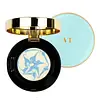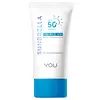What's inside
What's inside
 Key Ingredients
Key Ingredients

 Benefits
Benefits

 Concerns
Concerns

 Ingredients Side-by-side
Ingredients Side-by-side

Water
Skin ConditioningEthylhexyl Palmitate
EmollientButylene Glycol
HumectantEthylhexyl Methoxycinnamate
UV AbsorberZinc Oxide
Cosmetic ColorantCeresin
Emulsion StabilisingOctyldodecanol
EmollientEthylhexyl Salicylate
UV AbsorberCI 77891
Cosmetic ColorantCentella Asiatica Extract
CleansingOctocrylene
UV AbsorberBis-Ethylhexyloxyphenol Methoxyphenyl Triazine
Skin ConditioningHydrolyzed Hyaluronic Acid
HumectantHelichrysum Italicum Extract
AntiseborrhoeicHydrolyzed Elastin
EmollientCopper Tripeptide-1
Skin ConditioningPalmitoyl Pentapeptide-4
Skin ConditioningAcetyl Hexapeptide-8
HumectantOpuntia Coccinellifera Fruit Extract
Skin ConditioningMelaleuca Alternifolia Flower/Leaf/Stem Extract
Skin ConditioningOenothera Biennis Flower Extract
AstringentLavandula Angustifolia Flower Extract
CleansingPortulaca Oleracea Extract
Skin ConditioningSea Water
HumectantDimethicone
EmollientAluminum Hydroxide
EmollientMica
Cosmetic ColorantStearic Acid
CleansingHydrogen Dimethicone
Cetyl PEG/PPG-10/1 Dimethicone
EmulsifyingGlycyrrhiza Uralensis Extract
EmollientAdenosine
Skin ConditioningGlycerin
HumectantCaprylic/Capric Triglyceride
MaskingLecithin
EmollientPolysorbate 20
EmulsifyingSodium Ascorbyl Phosphate
AntioxidantTriethoxycaprylylsilane
Disodium EDTA
Phenoxyethanol
PreservativeCaprylyl Glycol
EmollientEthylhexylglycerin
Skin Conditioning1,2-Hexanediol
Skin ConditioningCI 77007
Cosmetic ColorantWater, Ethylhexyl Palmitate, Butylene Glycol, Ethylhexyl Methoxycinnamate, Zinc Oxide, Ceresin, Octyldodecanol, Ethylhexyl Salicylate, CI 77891, Centella Asiatica Extract, Octocrylene, Bis-Ethylhexyloxyphenol Methoxyphenyl Triazine, Hydrolyzed Hyaluronic Acid, Helichrysum Italicum Extract, Hydrolyzed Elastin, Copper Tripeptide-1, Palmitoyl Pentapeptide-4, Acetyl Hexapeptide-8, Opuntia Coccinellifera Fruit Extract, Melaleuca Alternifolia Flower/Leaf/Stem Extract, Oenothera Biennis Flower Extract, Lavandula Angustifolia Flower Extract, Portulaca Oleracea Extract, Sea Water, Dimethicone, Aluminum Hydroxide, Mica, Stearic Acid, Hydrogen Dimethicone, Cetyl PEG/PPG-10/1 Dimethicone, Glycyrrhiza Uralensis Extract, Adenosine, Glycerin, Caprylic/Capric Triglyceride, Lecithin, Polysorbate 20, Sodium Ascorbyl Phosphate, Triethoxycaprylylsilane, Disodium EDTA, Phenoxyethanol, Caprylyl Glycol, Ethylhexylglycerin, 1,2-Hexanediol, CI 77007
Water
Skin ConditioningEthylhexyl Methoxycinnamate
UV AbsorberGlycerin
HumectantDiethylamino Hydroxybenzoyl Hexyl Benzoate
UV FilterPropylene Glycol
HumectantOctocrylene
UV AbsorberCyclopentasiloxane
EmollientTrimethylsiloxysilicate
EmollientC14-22 Alcohols
Emulsion StabilisingDimethicone
EmollientCyclohexasiloxane
EmollientCaprylic/Capric Triglyceride
MaskingC20-22 Alkyl Phosphate
EmulsifyingC20-22 Alcohols
Emulsion StabilisingTitanium Dioxide
Cosmetic ColorantGlyceryl Stearate
EmollientPhenoxyethanol
PreservativeC12-20 Alkyl Glucoside
EmulsifyingSodium Acrylate/Sodium Acryloyldimethyl Taurate Copolymer
Emulsion StabilisingXanthan Gum
EmulsifyingSorbitan Stearate
EmulsifyingPolyhydroxystearic Acid
EmulsifyingIsohexadecane
EmollientHydroxyacetophenone
AntioxidantTriethanolamine
BufferingDipotassium Glycyrrhizate
HumectantAllantoin
Skin ConditioningHydrated Silica
AbrasivePolysorbate 80
EmulsifyingMenthol
MaskingParfum
MaskingBisabolol
MaskingTocopheryl Acetate
AntioxidantHydrogen Dimethicone
Aluminum Hydroxide
EmollientSorbitan Oleate
EmulsifyingDisodium EDTA
Squalane
EmollientButyl Methoxydibenzoylmethane
UV AbsorberHamamelis Virginiana Extract
AntiseborrhoeicPolyester-7
Skin ConditioningNeopentyl Glycol Diheptanoate
EmollientPseudoalteromonas Ferment Extract
HumectantButylene Glycol
HumectantZinc PCA
HumectantPropanediol
SolventZea Mays Starch
AbsorbentMyrothamnus Flabellifolia Leaf/Stem Extract
HumectantHydrolyzed Corn Starch
HumectantHydrolyzed Corn Starch Octenylsuccinate
AbsorbentButyrospermum Parkii Butter
Skin Conditioning1,2-Hexanediol
Skin ConditioningCocamidopropyl Dimethylamine
EmulsifyingBuddleja Officinalis Flower Extract
UV FilterSodium Salicylate
PreservativePhenylethyl Resorcinol
AntioxidantLactic Acid
BufferingPalmitoyl Tripeptide-5
Skin ConditioningMadecassoside
AntioxidantAsiaticoside
AntioxidantEthylhexylglycerin
Skin ConditioningMadecassic Acid
Skin ConditioningAsiatic Acid
Skin ConditioningWater, Ethylhexyl Methoxycinnamate, Glycerin, Diethylamino Hydroxybenzoyl Hexyl Benzoate, Propylene Glycol, Octocrylene, Cyclopentasiloxane, Trimethylsiloxysilicate, C14-22 Alcohols, Dimethicone, Cyclohexasiloxane, Caprylic/Capric Triglyceride, C20-22 Alkyl Phosphate, C20-22 Alcohols, Titanium Dioxide, Glyceryl Stearate, Phenoxyethanol, C12-20 Alkyl Glucoside, Sodium Acrylate/Sodium Acryloyldimethyl Taurate Copolymer, Xanthan Gum, Sorbitan Stearate, Polyhydroxystearic Acid, Isohexadecane, Hydroxyacetophenone, Triethanolamine, Dipotassium Glycyrrhizate, Allantoin, Hydrated Silica, Polysorbate 80, Menthol, Parfum, Bisabolol, Tocopheryl Acetate, Hydrogen Dimethicone, Aluminum Hydroxide, Sorbitan Oleate, Disodium EDTA, Squalane, Butyl Methoxydibenzoylmethane, Hamamelis Virginiana Extract, Polyester-7, Neopentyl Glycol Diheptanoate, Pseudoalteromonas Ferment Extract, Butylene Glycol, Zinc PCA, Propanediol, Zea Mays Starch, Myrothamnus Flabellifolia Leaf/Stem Extract, Hydrolyzed Corn Starch, Hydrolyzed Corn Starch Octenylsuccinate, Butyrospermum Parkii Butter, 1,2-Hexanediol, Cocamidopropyl Dimethylamine, Buddleja Officinalis Flower Extract, Sodium Salicylate, Phenylethyl Resorcinol, Lactic Acid, Palmitoyl Tripeptide-5, Madecassoside, Asiaticoside, Ethylhexylglycerin, Madecassic Acid, Asiatic Acid
Ingredients Explained
These ingredients are found in both products.
Ingredients higher up in an ingredient list are typically present in a larger amount.
1,2-Hexanediol is a synthetic liquid and another multi-functional powerhouse.
It is a:
- Humectant, drawing moisture into the skin
- Emollient, helping to soften skin
- Solvent, dispersing and stabilizing formulas
- Preservative booster, enhancing the antimicrobial activity of other preservatives
Aluminum Hydroxide is a form of aluminum. It can be naturally found in nature as the mineral gibbsite. In cosmetics, Aluminum Hydroxide is used as a colorant, pH adjuster, and absorbent.
As a colorant, Aluminum Hydroxide may add opacity, or reduce the transparency. Aluminum hydroxide is contains both basic and acidic properties.
According to manufacturers, this ingredient is an emollient and humectant. This means it helps hydrate the skin.
In medicine, this ingredient is used to help relieve heartburn and help heal ulcers.
There is currently no credible scientific evidence linking aluminum hydroxide in cosmetics to increased cancer risk.
Major health organizations allow the use of aluminum hydroxide in personal care products and have not flagged it as a carcinogenic risk at typical usage levels.
Learn more about Aluminum HydroxideButylene Glycol (or BG) is used within cosmetic products for a few different reasons:
Overall, Butylene Glycol is a safe and well-rounded ingredient that works well with other ingredients.
Though this ingredient works well with most skin types, some people with sensitive skin may experience a reaction such as allergic rashes, closed comedones, or itchiness.
Learn more about Butylene GlycolThis ingredient is an emollient, solvent, and texture enhancer. It is considered a skin-softener by helping the skin prevent moisture loss.
It helps thicken a product's formula and makes it easier to spread by dissolving clumping compounds.
Caprylic Triglyceride is made by combining glycerin with coconut oil, forming a clear liquid.
While there is an assumption Caprylic Triglyceride can clog pores due to it being derived from coconut oil, there is no research supporting this.
Learn more about Caprylic/Capric TriglycerideDimethicone is a type of synthetic silicone created from natural materials such as quartz.
What it does:
Dimethicone comes in different viscosities:
Depending on the viscosity, dimethicone has different properties.
Ingredients lists don't always show which type is used, so we recommend reaching out to the brand if you have questions about the viscosity.
This ingredient is unlikely to cause irritation because it does not get absorbed into skin. However, people with silicone allergies should be careful about using this ingredient.
Note: Dimethicone may contribute to pilling. This is because it is not oil or water soluble, so pilling may occur when layered with products. When mixed with heavy oils in a formula, the outcome is also quite greasy.
Learn more about DimethiconeDisodium EDTA plays a role in making products more stable by aiding other preservatives.
It is a chelating agent, meaning it neutralizes metal ions that may be found in a product.
Disodium EDTA is a salt of edetic acid and is found to be safe in cosmetic ingredients.
Learn more about Disodium EDTAEthylhexyl Methoxycinnamate is an organic compound that provides UVB protection. It often goes by the more common name of octinoxate. It is created from methoxycinnamic acid and 2-ethylhexanol.
Ethylhexyl Methoxycinnamate absorbs UVB rays with wavelengths between 280-320 nm. UV absorbers protect your skin by using chemical reactions to convert UV rays into heat and energy.
UVB (290-320 nm) rays emit more energy than UVA rays. They are capable of damaging DNA, causing sunburns and are thought to be linked to skin cancer.
The state of Hawaii has banned sunscreens containing octinoxate due to its potential impact on coral reefs. More research is needed to bridge gaps in this research. The European Union allows higher levels of octinoxate in sunscreens than the US and Australia.
Ethylhexyl Methoxycinnamate is oil soluble. It is not stable and may lose efficacy when exposed to sunlight.
Learn more about Ethylhexyl MethoxycinnamateEthylhexylglycerin (we can't pronounce this either) is commonly used as a preservative and skin softener. It is derived from glyceryl.
You might see Ethylhexylglycerin often paired with other preservatives such as phenoxyethanol. Ethylhexylglycerin has been found to increase the effectiveness of these other preservatives.
Glycerin is already naturally found in your skin. It helps moisturize and protect your skin.
A study from 2016 found glycerin to be more effective as a humectant than AHAs and hyaluronic acid.
As a humectant, it helps the skin stay hydrated by pulling moisture to your skin. The low molecular weight of glycerin allows it to pull moisture into the deeper layers of your skin.
Hydrated skin improves your skin barrier; Your skin barrier helps protect against irritants and bacteria.
Glycerin has also been found to have antimicrobial and antiviral properties. Due to these properties, glycerin is often used in wound and burn treatments.
In cosmetics, glycerin is usually derived from plants such as soybean or palm. However, it can also be sourced from animals, such as tallow or animal fat.
This ingredient is organic, colorless, odorless, and non-toxic.
Glycerin is the name for this ingredient in American English. British English uses Glycerol/Glycerine.
Learn more about GlycerinHydrogen Dimethicone is a type of silicone.
Octocrylene protects skin from sun damage. It absorbs UV-B with peak absorption of 304 nm. It is a common sunscreen ingredient and often paired with avobenzone, a UVA filter. This is because octocrylene stabilizes other sunscreen ingredients by protecting them from degradation when exposed to sunlight. Octocrylene is a photostable ingredient and loses about 10% of SPF in 95 minutes.
Octocrylene also acts as an emollient, meaning it helps skin retain moisture and softens skin. It is oil-soluble and hydrophobic, enhancing water-resistant properties in a product.
Those who are using ketoprofen, a topical anti-inflammatory drug, may experience an allergic reaction when using octocrylene. It is best to speak with a healthcare professional about using sunscreens with octocrylene.
The EU allows a maximum of these concentrations:
Learn more about OctocrylenePhenoxyethanol is a preservative that has germicide, antimicrobial, and aromatic properties. Studies show that phenoxyethanol can prevent microbial growth. By itself, it has a scent that is similar to that of a rose.
It's often used in formulations along with Caprylyl Glycol to preserve the shelf life of products.
Water. It's the most common cosmetic ingredient of all. You'll usually see it at the top of ingredient lists, meaning that it makes up the largest part of the product.
So why is it so popular? Water most often acts as a solvent - this means that it helps dissolve other ingredients into the formulation.
You'll also recognize water as that liquid we all need to stay alive. If you see this, drink a glass of water. Stay hydrated!
Learn more about Water